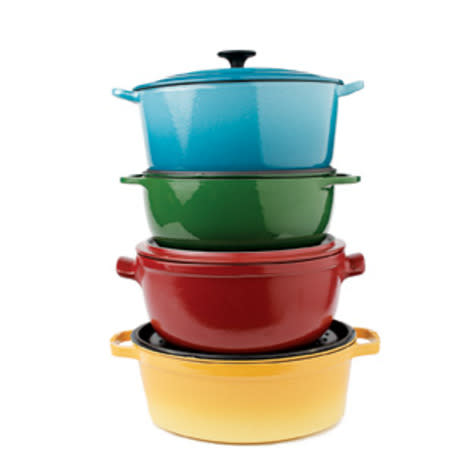6 Pots Every Cook Needs
By Jessie Price, Deputy Editor: Food for EatingWell Magazine

Most weekends in the kitchen of my first apartment in San Francisco I would pull out my Dutch oven (one of the few pots I owned) and make a big steaming cauldron of soup. Everything went into the one pot. When I was done, all I had to clean was my cutting board and that pot. It was so simple, but the soups were satisfying, healthy and delicious.
Today I have plenty of counter space and all the pots and pans and kitchen doodads I could hope for, but what I lack most often is time. Cooking a meal all in one pot is perfect for anyone who is busy and wants to get a healthy dinner on the table with little fuss. Having a few good-quality pots at your disposal puts you on the fast track to dinners that are just as easy to clean up after as they are to make. Here are 6 pots every kitchen should have:
Recipes to try: One-Pot Recipes for Easy Weeknight Meals
1. Skillet
There are three types of skillets that every cook should have: stainless, nonstick and cast-iron. Nonstick skillets allow you to use less oil, and cook delicate foods like eggs without fear of sticking. Be sure to look for a nonstick skillet made without PTFE and PFOA: these pans are marketed as "green" or "eco-friendly" and have coatings that won't break down when used over high heat. Cast-iron skillets are a tried-and-true favorite because you can cook with them over high heat and put them in the oven safely. And a stainless skillet made out of heavy material, which conducts heat evenly, will last for years and is a worthwhile investment.
Recipes to try: Healthy One-Skillet Recipes
2. Wok
For as little as $30 you can get a great wok that will last for years. Choose a carbon-steel wok with a flat bottom-they're light, easy to hold and move, and the flat bottom allows them to sit directly on the burner of your stove, so they get hot enough. Avoid nonstick woks-most nonstick cookware should not be used over high heat, and many wok stir-fries require high heat for the best results.
Recipes to try: Quick & Healthy Stir-Fry Recipes
3. Roasting Pan
Choose a roasting pan made of heavy metal so it won't warp. A basic 14-by-16-inch one with sturdy handles is good for most recipes (and will work for your holiday turkey as well). If you're roasting a small amount of food, use a smaller metal pan, about 9 by 13 inches, to keep the pan from drying out and burning. Even though shiny stainless pans are pretty, we find that darker pans brown foods better and make the morsels on the bottom of the pan more luscious for gravy.
4. Casserole
When we call for a "casserole" we mean a shallow glass or ceramic dish. Sometimes these sorts of dishes have lids, but they are not necessary; you can use foil for food that needs to be cooked covered. If you're only going to get one casserole dish, go for a 9-by-13-inch (or similar-size) one that holds 3 quarts. You may also want a smaller 7-by-11-inch or 2-quart dish. Glass dishes are great because they're inexpensive and available at the supermarket. Spend a little more and you can get a ceramic dish that looks pretty on the table and is safe to use under the broiler.
Recipes to try: 22 Make-Ahead Casseroles to Feed the Whole Family
5. Slow Cooker
Choose a 5- to 6-quart slow cooker with an adjustable timer that lets you set the time manually and automatically switches to "warm" when the cook time is up. The switch-to-warm feature keeps your food at a safe temperature, so you don't need to be there when it finishes cooking.
Recipes to try: Our Best Healthy Recipes for a Crock Pot
6. Dutch Oven
A 5- to 6-quart Dutch oven is a good all-purpose size that will work for many recipes, from cooking pasta to braising beef. We use both stainless-steel and enamel-coated cast-iron pots and find that the heavier and sturdier the material, the better it conducts heat and keeps foods from scorching. Check to make sure the lid is tight-fitting to keep moisture in.
What cookware can't you live without?
By Jessie Price

Jessie Price is the deputy editor of food for EatingWell magazine, where she directs all food content. Besides her work on 11 other EatingWell books, she is the author of the James Beard Award-winning The Simple Art of EatingWell and EatingWell One-Pot Meals. She lives in Charlotte, Vermont where she stays busy growing her own vegetables in the summer and tracking down great Vermont food products when she's not working.
Related Links from EatingWell:
